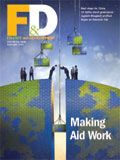AID and Development

Making Aid Work
Peter S. Heller
Rich countries aim to confront persistent poverty in much of the
developing world with plans to boost aid, cancel debts of poor countries,
and increase trade access for goods from developing nations. But
scaling up aid flows is just the start of a complex set of decisions
and tough choices. Donor and recipient countries will still need
to ensure that the aid actually achieves results, given the spotty
record so far. It is critical, therefore, that any large increase
in aid be accompanied by considered efforts to ensure that lessons
of the past are learned and that new challenges are anticipated.
Picture This

Aiding Development: Tracking the Flows
Bilal Siddiqi
Chart-based analysis of which countries give the most aid and where
the money goes.
Aid and Growth
Steven Radelet, Michael Clemens, and Rikhil Bhavnani
New evidence shows that aid flows aimed at growth have produced
results. The authors argue that policy discussions should not focus
exclusively on determining the limits of aid on growth, but rather
on how those limits can be expanded so that aid can be made more
effective in supporting development.
The MDGs: Building Momentum
Andy Berg and Zia Qureshi
A big push to deliver more aid is not the sole answer to achieving
the Millennium Development Goals; rather aid must be combined with
a concerted drive to improve trade access, encourage private capital
flows, promote technology transfer, and enhance domestic expenditure
management.
Coping with Aid Volatility
Benn Eifert and Alan Gelb
As the amount of aid increases, the volatility of aid flows may
also rise. But there are ways to tackle the problem, particularly
if donors lengthen funding horizons.
The Macroeconomic Challenge of More Aid
Shekhar Aiyar, Andrew Berg, and Mumtaz Hussain
How should countries react to a large increase in aid inflows? An
analysis of five African countries that received big increases in
aid—Ethiopia, Ghana, Mozambique, Tanzania, and Uganda—offers
useful lessons for other developing countries. |
 |
Ethiopia: Scaling Up
David Andrews, Lodewyk Erasmus, and Robert Powell
Ethiopia, among the poorest countries in Africa, presents one of the
biggest development challenges in a region beset by frequent drought
and hobbled by inadequate infrastructure. Would a dramatic increase
in aid really help? An analysis illustrates the considerable challenges
of attempting to promote faster development through more aid.
Debating Aid

U.K.: More Country Ownership
Sam Sharpe, Adrian Wood, and Ellen Wratten
Like many other donors, the United Kingdom says experience shows that
a "country-led" approach, in which the governments of
developing countries themselves define and lead the poverty reduction
agenda, is the key to improving aid effectiveness.
Tanzania: "Smart" Partnerships
Basil P. Mramba
Tanzania’s finance minister says that
a clear national development vision upon which donor support can be
anchored is critical for ensuring that aid is well used.
Burkina Faso: Greater Capacity
Jean-Baptiste Compaoré
In Burkina Faso, only about 70 percent of aid
committed by donors is effectively disbursed. The country’s
finance minister says that improving absorption capacity is crucial
if a scaling up of aid is to be effective.
Also
in This Issue

Next Steps for China
Eswar S. Prasad
The exchange rate regime is just one piece of the broader reform agenda
in China. The author assesses what China needs to do to ensure the
durability of its economic expansion by addressing the looming issues
of financial sector reform and the need to bolster balanced domestic-led
growth.
Economic Spillovers
Vivek Arora and Athanasios Vamvakidis
Trading partners matter significantly for a country’s growth.
Research shows that countries benefit relatively more if their trading
partners grow faster than they themselves do and are richer. |
Departments

Letter from the Editor
In Brief

News from international agencies
AIDS battle needs urgent new funding; encouraging
breastfeeding; tsunami follow up; OECD on workers and globalization;
IDA shift to grants for the poorest; IMF-World Bank promote standards
and codes.
People in Economics

The Globalization Guru
Arvind Subramanian interviews Jagdish Bhagwati, a
leading economist in the area of trade and development and a tireless
opponent of protectionism and advocate of free trade.
Back to Basics

10 Myths About Governance and Corruption
Daniel Kaufmann
A bolder approach is needed to improve governance and curb corruption
around the world. The World Bank Institute is designing a transparency
reform scorecard and constructing a transparency index to complement
its well-known governance indicators.
Book Reviews

And the Money Kept Rolling
In (and Out): Wall Street, the IMF, and the Bankrupting of Argentina,
Paul Blustein
Chasing Dirty Money: The Fight Against
Money Laundering, Peter Reuter and Edwin M. Truman
Governance and the Sclerosis that Has
Set In, Arun Shourie
Straight Talk

Risky Business
Raghuram Rajan
The IMF’s Economic Counsellor argues that skewed incentives
for investment managers may be adding to global financial risk.
While the techniques and instruments to absorb fluctuations have
improved, there is a great deal of uncertainty about how they will
perform in a serious downturn.
Country Focus

China
Economic growth has remained strong and inflation
low. A large trade surplus, together with strong capital inflows,
has kept accumulation of official reserves high. In July, China
abandoned the de facto peg of its currency to the U.S. dollar and
moved to a managed floating exchange rate arrangement linked to
a basket of currencies, with an initial 2 percent revaluation against
the dollar.
|
